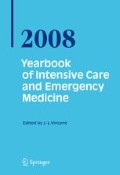Abstract
Although measurement of oxygen consumption in the clinical setting is hampered by numerous technical difficulties, the objective of hemodynamic resuscitation is to ensure that oxygen consumption balances the metabolic needs of the body [1]–[3]. When the hemoglobin level is stable, oxygen consumption is determined by three interrelated variables: Cardiac output, arterial oxygen saturation, and mixed venous oxygen saturation (SvO2). This explains the considerable efforts that have been devoted to develop tools to measure and monitor each of these three variables. Such tools are important for diagnosis, optimization of treatment, and tracking progress of patients with hemodynamic compromise [4].
Access this chapter
Tax calculation will be finalised at checkout
Purchases are for personal use only
Preview
Unable to display preview. Download preview PDF.
References
Gilbert EM, Haupt MT, Mandanas RY, Huaringa AJ, Carlson RW (1986) The effect of fluid loading, blood transfusion, and catecholamine infusion on oxygen delivery and consumption in patients with sepsis. Am Rev Respir Dis 134:873–878
Russell JA, Phang PT (1994) The oxygen delivery/consumption controversy. Approaches to management of the critically ill. Am J Respir Crit Care Med 149:533–537
Squara P (2004) Matching total body oxygen consumption and delivery: a crucial objective? Intensive Care Med 30:2170–2179
Cruz K, Franklin C (2001) The pulmonary artery catheter: uses and controversies. Crit Care Clin 17:271–291
Boldt J, Menges T, Wollbruck M, Hammermann H, Hempelmann G (1994) Is continuous cardiac output measurement using thermodilution reliable in the critically ill patient? Crit Care Med 22:1913–1918
Rubini A, Del Monte D, Catena V, et al (1995) Cardiac output measurement by the thermodilution method: an in vitro test of accuracy of three commercially available automatic cardiac output computers. Intensive Care Med 21:154–158
Haller M, Zollner C, Briegel J, Forst H (1995) Evaluation of a new continuous thermodilution cardiac output monitor in critically ill patients: a prospective criterion standard study. Crit Care Med 23:860–866
Sandham JD, Hull RD, Brant RF, et al (2003) A randomized, controlled trial of the use of pulmonary-artery catheters in high-risk surgical patients. N Engl J Med 348:5–14
Frezza EE, Mezghebe H (1998) Indications and complications of arterial catheter use in surgical or medical intensive care units: analysis of 4932 patients. Am Surg 64:127–131
Kac G, Durain E, Amrein C, Herisson E, Fiemeyer A, Buu-Hoi A (2001) Colonization and infection of pulmonary artery catheter in cardiac surgery patients: epidemiology and multivariate analysis of risk factors. Crit Care Med 29:971–975
Gratz I, Kraidin J, Jacobi AG, deCastro NG, Spagna P, Larijani GE (1992) Continuous noninvasive cardiac output as estimated from the pulse contour curve. J Clin Monit 8:20–27
Spohr F, Hettrich P, Bauer H, Haas U, Martin E, Bottiger BW (2007) Comparison of two methods for enhanced continuous circulatory monitoring in patients with septic shock. Intensive Care Med 33:1805–1810
de Wilde RB, Schreuder JJ, van den Berg PC, Jansen JR (2007) An evaluation of cardiac output by five arterial pulse contour techniques during cardiac surgery. Anaesthesia 62:760–768
de Waal EE, Kalkman CJ, Rex S, Buhre WF (2007) Validation of a new arterial pulse contourbased cardiac output device. Crit Care Med 35:1904–1909
Rocco M, Spadetta G, Morelli A, et al (2004) A comparative evaluation of thermodilution and partial CO2 rebreathing techniques for cardiac output assessment in critically ill patients during assisted ventilation. Intensive Care Med 30:82–87
Su NY, Huang CJ, Tsai P, Hsu YW, Hung YC, Cheng CR (2002) Cardiac output measurement during cardiac surgery: esophageal Doppler versus pulmonary artery catheter. Acta Anaesthesiol Sin 40:127–133.
Bernstein DP (1986) Continuous noninvasive real-time monitoring of stroke volume and cardiac output by thoracic electrical bioimpedance. Crit Care Med 14:898–901
Kubicek W, Patterson R, Witsoe D (1966) Development and evaluation of an impedance cardiac output system. Aerosp Med 37:1208–1212
Barin E, Haryadi D, Schookin S, et al (2000) Evaluation of a thoracic bioimpedance cardiac output monitor during cardiac catheterization. Crit Care Med 28:698–702
Spiess B, Patel M, Soltow L, Wright I (2001) Comparison of bioimpedance versus thermodilution cardiac output during cardiac surgery: evaluation of a second-generation bioimpedance device. J Cardiothorac Vasc Anesth 15:567–573
Leslien S, McKee S, Newby D, Webb D, Denvir M (2004) Non-invasive measurement of cardiac output in patients with chronic heart failure. Blood Press Monit 9:277–280
Engoren M, Barbee D (2005) Comparison of cardiac output determined by bioimpedance, thermodilution, and the Fick method. Am J Crit Care 14:40–45
Keren H, Burkhoff D, Squara P (2007) Evaluation of a noninvasive continuous cardiac output monitoring system based on thoracic bioreactance. Am J Physiol Heart Circ Physiol 293:H583–589
Squara P, Denjean D, Estagnasie P, Brusset A, Dib JC, Dubois C (2007) Noninvasive cardiac output monitoring (NICOM): a clinical validation. Intensive Care Med 33:1191–1194
Sramek B (1981) Non invasive technique for measurements of cardiac output by mean of electrical impedance. Proceedings of the fifith international conference on electric bioimpedance, Tokyo, 39–42
Squara P, Marqué S, Cariou A, Chiche JD (2007) Non invasive cardiac output monitoring (NICOM) compared to minimally invasive monitoring (VIGILEO). Anesthesiology 107:A1527 (abst)
Author information
Authors and Affiliations
Rights and permissions
Copyright information
© 2008 Springer-Verlag Berlin Heidelberg
About this paper
Cite this paper
Squara, P. (2008). Bioreactance: A New Method for Non-invasive Cardiac Output Monitoring. In: Yearbook of Intensive Care and Emergency Medicine. Yearbook of Intensive Care and Emergency Medicine, vol 2008. Springer, Berlin, Heidelberg. https://doi.org/10.1007/978-3-540-77290-3_58
Download citation
DOI: https://doi.org/10.1007/978-3-540-77290-3_58
Publisher Name: Springer, Berlin, Heidelberg
Print ISBN: 978-3-540-77289-7
Online ISBN: 978-3-540-77290-3
eBook Packages: MedicineMedicine (R0)

